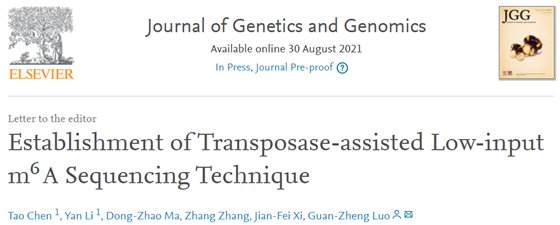

Published on Oct. 7, 2021, by Admin in the Luo Lab

On August 30, our lab published the article of " Establishment of Transposase-assisted Low-input m6A Sequencing Technique " online in Journal of Genetics and Genomics. Congratulations to Tao Chen, Yan Li, Dong-Zhao Ma, Zhang Zhang and Jian-Fei Xi!
RNA modification has been recognized as a pivotal regulator that affects gene expression in a post-transcriptional manner. To date, the N6-methyladenosine (m6A) is the most abundant and best-characterized internal modification in mRNAs, which plays a critical role in multiple pathological processes, suggesting the potential role of m6A as a biomarker in disease diagnosis. The most widely used transcriptome-wide m6A profiling method depends on RNA immunoprecipitation assay, of which m6A-specific antibody is adopted to enrich m6A modified RNA fragments for deep sequencing (MeRIP-seq or m6A-seq). A recent study refined the conventional MeRIP-seq protocol and reduced the starting total RNA to 2 μg. However, sufficient material is still a prerequisite that restricts this technique to cell cultures or easily acquired tissue samples. To reduce the starting material for m6A profiling, we introduced transposase Tn5 into the main procedure of MeRIP library preparation and proposed the new method tMeRIP-seq (transposase-assisted MeRIP-seq). We first converted polyA+ mRNA from low-input total RNA to mRNA/DNA hybrids using oligo(dT) primer. The mRNA/DNA hybrid was then randomly sheared to ~200 nt in length by Tn5 tagmentation, combined with adaptor ligation into a single step. The resulting product was then subjected to immunoprecipitation using anti-m6A antibody. Based on this strategy, we used as little as 60 ng total RNA as the starting template and identified thousands of repeatable m6A sites, which are specifically enriched near the stop codon of genes and have typical RRACH motifs. Finally, we applied this technology to a drop of blood in simulation of clinical diagnosis and found that multiple blood disease-related genes may be regulated by m6A. Based on similar principles, tMeRIP-Seq technology may also be extended to other RNA modification studies in the future.
By Fu Wu